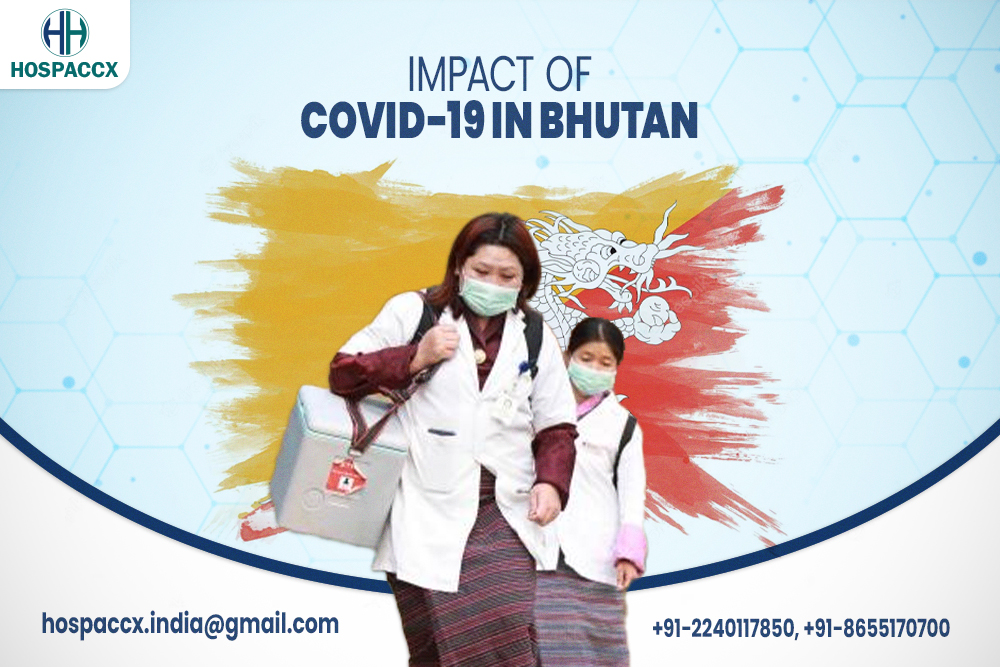Impact of Covid in Bhutan
COVID-19 has revealed ongoing inequities based on income, age, ethnicity, gender, and region. Despite recent global health achievements, individuals across the globe continue to face complex, interwoven challenges to their health and well-being that are rooted in social, economic, political, and environmental determinants of health.
Bhutan managed to avoid large-scale domestic COVID-19 outbreak in the country through a series of proactive and well thought of actions, such as, stringent containment measures which included two nationwide lockdowns since 2020 after Bhutan verified its first COVID-19 case on March 6, 2020: a 76-year-old US male who entered the nation via India. Around 90 persons who had direct contact with him, as well as his 59-year-old spouse, driver, and guide, were quickly tracked down and quarantined.
Present situation of COVID-19 in Bhutan
The first case of COVID-19 in Bhutan was identified on March 6, 2020 whereas the first death was confirmed on January 7, 2021. In Bhutan, from 3 January 2020 to 14 April 2022, there have been 49,066 confirmed cases of COVID-19 with 16 deaths, reported to WHO. As of 9 April 2022, a total of 1,888,156 vaccine doses have been administered.
Government Response
Closing of Borders and Schools
Upon confirmation of the first case of COVID-19 in the country, Bhutan immediately suspended all tourist visas and restricted entry of foreign tourists for two weeks. Schools in three areas including capital Thimphu were closed.
Bhutan also rolled out a rigorous response to contain the spread of the virus with a mandatory 21-day quarantine and tests for all Bhutanese returning to the country. The expenses for the quarantine were paid for by the government; by November 2020, Nu. 289,653 million was spent on quarantine facilities.
Financial Relief to Impacted Families
The negative impact on the economy, with the tourist and service sectors grinding to a halt due to the closing of international borders since late March 2020, led to the formation of a National Resilience Fund. Based on the Royal order, the National Resilience Fund (NRF) with a fund size of Nu. 30,000 million was formed in April 2020, under which the Druk Gyalpo’s Relief Kidu was founded (DGRK). This funding offered relief and financial support to those whose livelihoods were harmed by the epidemic. Financial assistance was provided to 34,384 individuals, including almost 25,000 children.
Numerous fiscal and monetary measures were also made available, including the postponement of debts for two years until June 2022, as well as a six-month interest-free period from April to September 2020.
Enforcing Safety Measures
The Health Ministry also advocated for preventative measures such as strict cleanliness and safety regulations, as well as the usage of the recently developed Druk Trace app and the Check Post Management System (CPMS) to trace persons and vehicles’ movements. The mandated safety standards in public areas, as well as vehicle and people movement registration, were the first line of defence against the virus. The daily situational updates and announcements on the Health Ministry’s website, as well as the regular news briefings, helped to keep people informed about where covid cases were appearing.
Impact on Healthcare
While the outbreak itself has so far affected Bhutan somewhat less than many other countries, the economic and social effects are significant. In 2019, the country had around 3000 health professionals and 376 medical physicians (including only one ICU-trained physician), much less than the WHO-recommended doctor-to-population ratio of 1:1000. To avoid becoming a hub for infection and to limit community spread, the government created containment policies for its main hospitals. Every health professional and patient is tested for COVID-19 before entering the hospital. Even before Bhutan’s first COVID-19 positive case, every patient admitted to the hospital with an acute respiratory illness was tested using the country’s newly built COVID integrated influenza surveillance system.
Rising Cases
COVID-19 infections are increasing in Bhutan, with 1,644 new infections reported on average each day. That’s 96% of the peak — the highest daily average reported on April 14.
Impact on Nutrition
Bhutan’s food and nutrition security are fragile to events such as disasters and pandemics as the country still imports about 50 percent of its total food consumption. Food prices have increased by approximately 15 percent over the last year and have cast a shadow on food security and livelihoods of vulnerable people. At the beginning of the pandemic, UNICEF estimated a 30 percent overall reduction in essential nutrition services coverage, reaching 75–100 percent in lockdown contexts. Estimates predict a 14.3 percent increase in the prevalence of moderate or severe wasting among children under 5 years of age, equal to an additional 6.7 million children.
Covid-19 Vaccination
On March 27, 2021, Bhutan began its COVID-19 immunisation rollout, and within two weeks, it had reached more than 90 percent of the adult population eligible for vaccination (adults 18 years and older). The percentage was a higher proportion of its population than in well-resourced nations such as the Middle East and Europe, where vaccination efforts had begun months earlier. Despite having a modest overall population of roughly 750 000 individuals, vaccination of nearly 470 000 eligible adults with their first dose of COVID-19 vaccine in such a short period of time was outstanding.
Economic and Social Impact
Bhutan has carried out early and decisive measures to contain the spread of the coronavirus disease (COVID-19), including restrictions on tourists since March 2020. While this approach resulted in effectively containing the spread of COVID-19, it severely affected the economy with some sectors such as tourism and aviation coming to a virtual standstill.
Income Grant
As part of its reaction to the epidemic, the government established a one-year income grant to mitigate the burden of income loss. Banks around the country agreed to waive loan interest rates for six months. Bhutan’s government has also provided free 1GB data to all consumers who use Bhutanese mobile providers.
Impact on Education
All schools in the nation have been shuttered, forcing over 190,000 pupils to take lectures online. In addition to radio broadcasts, printed study materials are supplied to students who do not have access to the internet.
Conclusion
COVID-19 has caused a major socioeconomic impact on the lives of people in Bhutan, a landlocked nation situated in the eastern Himalayas. The pandemic has led to the closure of its international border, restriction on cross-border trade, closure of businesses, schools and colleges, and restrictions on social gatherings. Despite limitations of resources and experiences, Bhutan has achieved good control of the pandemic through its unique public health approaches.
Bhutan drew from its earlier experiences of a well-established primary healthcare system and high coverage of immunisation in delivering COVID-19 vaccine to almost all of its adult population. This was achieved through proper planning, judicious use of health resources and a strong central leadership. Bhutan fully vaccinated 90% of its adult population with COVID-19 vaccine within a span of two weeks in April 2021.
However, the country now has to explore means to vaccinate the children. Another threat that arises from this vaccination effort is the possible decline in compliance to public health measures and complacency that may be counterproductive in the background of new strains of the SARS-CoV-2 virus. The country also faces the daunting task of preventing complacency in physical distancing measures, hand washing and use of face masks by the public in a background of the rapid spread of new strains of SARS-CoV-2.
For more information about the Country and Healthcare opportunities in Bhutan, you can visit the company website on www.hospaccxconsulting.com or contact us directly.
Related Team Members
Related Services
Other Industries
Related Blog
Related Success Stories










